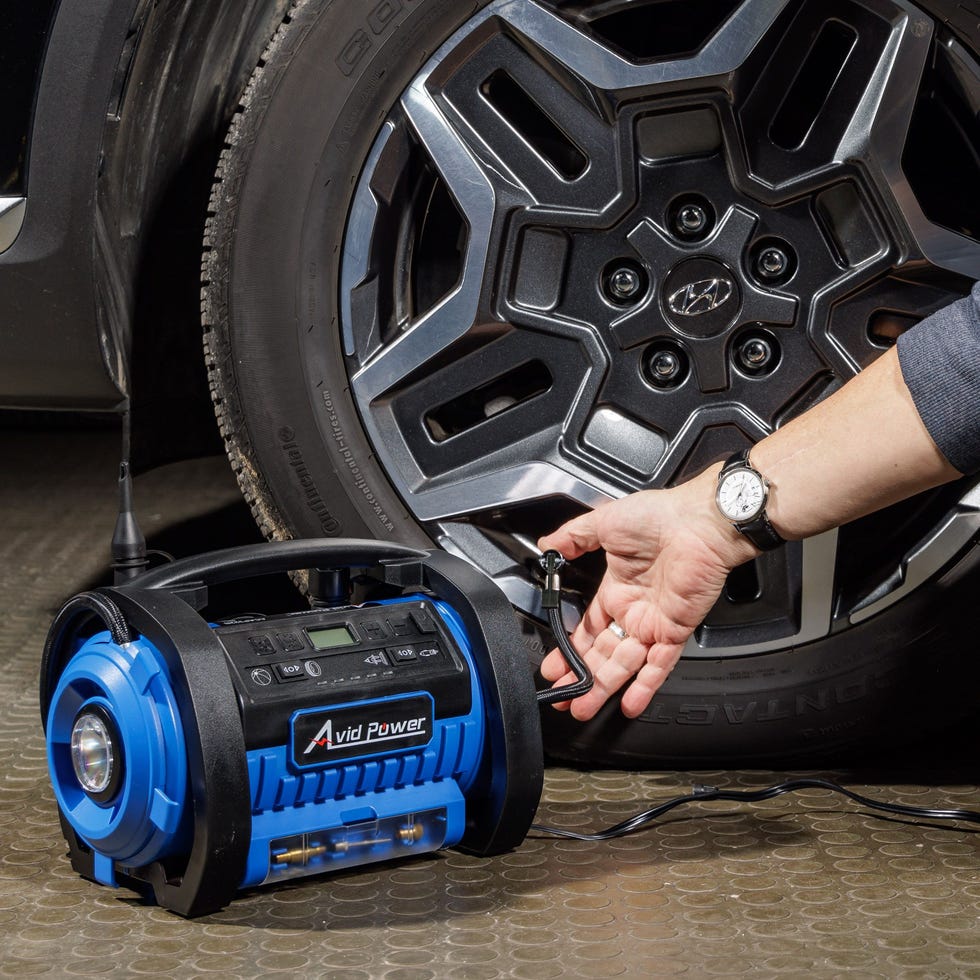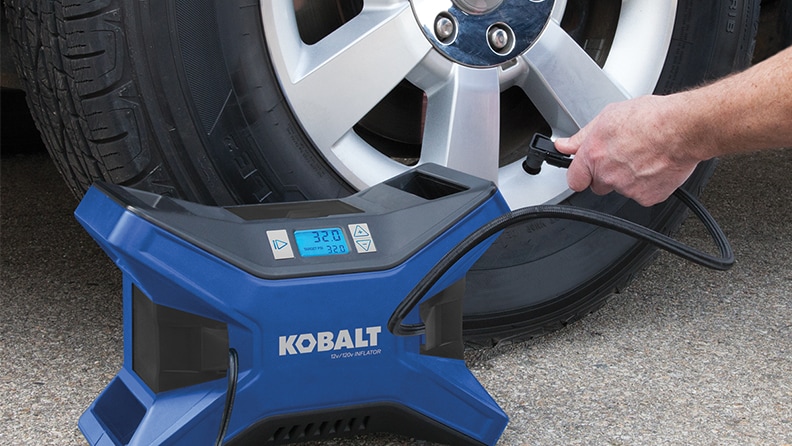To fill up a tire with an air compressor, first, attach the hose to the valve stem, then turn on the compressor and inflate the tire to the recommended pressure for your vehicle. It is essential to ensure that the hose is securely attached to the valve stem and that the compressor is turned off before removing the hose to prevent any air leakage.
When it comes to maintaining the optimal tire pressure, using an air compressor is an efficient and straightforward method. Properly inflated tires improve fuel efficiency, prolong tire lifespan, and enhance vehicle safety. This process not only saves time but also promotes cost-effective vehicle maintenance.
By understanding the basic steps of using an air compressor to fill up a tire, you can easily and effectively maintain your vehicle’s tire pressure, ensuring a smooth and safe driving experience.

Credit: m.youtube.com
Importance Of Proper Tire Inflation
Maintaining proper tire inflation is crucial for optimal vehicle performance and safety. To fill up a tire with an air compressor, start by checking the recommended pressure, then attach the air hose and fill the tire. Regularly monitoring tire pressure prevents uneven wear and improves fuel efficiency.
Safety On The Road
Ensuring proper tire inflation is crucial to maintaining your safety on the road. When your tires are not properly inflated, it can lead to various problems that can compromise your driving experience. One of the major concerns is the increased risk of tire blowouts. When the tire pressure is too low, it causes excessive heat build-up, which weakens the tire structure. This can result in a sudden tire blowout, leading to loss of control over your vehicle.
In addition to the risk of blowouts, improper tire inflation can also have a negative impact on your handling and braking performance. When your tires are underinflated, it affects the contact patch between the tire and the road surface, reducing your vehicle’s grip. This can lead to longer braking distances, poor steering response, and an overall decrease in control. On the other hand, overinflated tires can have a reduced contact patch, resulting in less traction and stability on the road.
Optimal Vehicle Performance
Proper tire inflation goes beyond just safety concerns, as it also plays a significant role in ensuring optimal vehicle performance. When your tires are at the recommended pressure, it helps maximize fuel efficiency. Underinflated tires create more rolling resistance, which requires your engine to work harder and consume more fuel.
Besides fuel efficiency, proper tire inflation also has an impact on the longevity of your tires. Tires that are consistently under or overinflated are more prone to uneven tread wear, reducing their overall lifespan. By maintaining the right tire pressure, you can ensure a more even distribution of weight and wear, ultimately extending the life of your tires and saving you money in the long run.
Moreover, properly inflated tires contribute to a smoother and more comfortable ride. When your tires are at the correct pressure, they absorb road imperfections better, reducing vibrations and providing a more pleasant driving experience. It also helps improve your vehicle’s handling and maneuverability, allowing you to have better control while driving in various road conditions.
Equipment Needed
When it comes to filling up a tire with an air compressor, you’ll need to ensure you have the right equipment on hand. Understanding the equipment needed is crucial for a smooth and efficient process.
Air Compressor
An air compressor is an essential piece of equipment for filling up a tire. It works by converting power into potential energy stored in pressurized air. When selecting an air compressor, consider its cubic feet per minute (CFM) rating and its pounds per square inch (PSI) capabilities. An ideal air compressor for tire filling should have a high enough CFM and PSI to efficiently fill tires, especially larger ones.
Tire Pressure Gauge
A tire pressure gauge is a must-have tool for accurately measuring the air pressure within your tires. There are various types of pressure gauges available, including digital and analog options. Ensure that the pressure gauge you use is suitable for the air pressure range required for your tires. Keeping a tire pressure gauge handy is essential for maintaining safe and optimal tire pressure levels.
Step-by-step Guide To Filling Up A Tire
When it comes to maintaining your vehicle, one essential task is ensuring that your tires are properly inflated. Proper tire pressure not only improves fuel efficiency but also enhances safety and extends the life of your tires. In this step-by-step guide, we’ll walk you through the process of filling up a tire using an air compressor. By following these simple steps, you can easily and efficiently keep your tires at the optimal pressure.
Check Current Tire Pressure
Before filling up your tire, it’s crucial to check the current tire pressure using a reliable tire pressure gauge. Refer to your vehicle’s manual or the sticker inside the driver’s side door for the recommended pressure level. Ensure that the tires are cold before checking the pressure to obtain an accurate reading.
Connect Air Compressor To Tire Valve
Once you’ve determined the required tire pressure, locate the valve stem on the tire and remove the valve cap. Attach the air compressor’s hose securely to the valve stem. Check that the connection is tight to prevent any air leaks during the inflation process.
Inflate The Tire
With the air compressor properly connected, switch it on and begin inflating the tire. Monitor the pressure using the gauge built into the compressor or a separate tire pressure gauge. Stop periodically to check the pressure and ensure it does not exceed the recommended level. Slowly add air, as needed, until the desired pressure is reached.
Check Pressure Again
After inflating the tire, recheck the pressure using a tire pressure gauge to confirm that it matches the recommended level. It’s essential to validate the accuracy of the pressure to guarantee optimal tire performance and safety on the road.
Disconnect And Replace Valve Cap
Once the tire is filled to the appropriate pressure, switch off the air compressor and detach the hose from the valve stem. Quickly replace the valve cap to protect the valve from dirt, moisture, and damage. Ensure that the cap is securely tightened to keep the valve sealed.

Credit: m.youtube.com
Tips For Safe And Effective Tire Inflation
Learn how to safely and effectively fill up a tire with an air compressor. Follow these essential tips to ensure your tires are properly inflated for optimal performance and safety on the road.
Avoid Overinflation
Overinflating your tires can lead to a dangerous situation on the road. When you fill up your tires with an air compressor, make sure to avoid exceeding the recommended tire pressure.
Overinflated tires are not only more prone to blowouts but can also result in a rough and uncomfortable ride. They can reduce traction and make it harder to control your vehicle, especially in wet or icy conditions.
Check Tire Pressure Regularly
Regularly monitoring your tire pressure is key to maintaining the safety and longevity of your tires. It’s a good practice to check your tire pressure at least once a month and before long trips.
Remember, underinflated tires can be just as dangerous as overinflated ones. Low tire pressure can affect your vehicle’s handling, reduce fuel efficiency, and increase the risk of tire damage.
To check the tire pressure, you’ll need a tire pressure gauge. Remove the valve cap from the tire, place the gauge on the valve stem, and press down firmly until the gauge reads the pressure. Compare the reading to the recommended pressure stated in your vehicle’s owner manual or on the driver’s side door jamb.
If the pressure is too low, use an air compressor to fill the tire until it reaches the correct level. Be sure to check the pressure again after adding air to ensure it is accurate.
By keeping a close eye on your tire pressure, you can ensure optimal performance, fuel efficiency, and safety on the road.
Troubleshooting Common Issues
If you’re having trouble filling up a tire with an air compressor, there are a few common issues you might encounter. First, check for leaks in the air hose or the tire valve. You should also ensure that the air compressor is properly connected and turned on.
If the tire still won’t fill up, the issue may be with the tire valve itself, which may need to be replaced.
Air Leaks
Air leaks are a common issue when filling tires with an air compressor. Inspect the tire valve and connections to ensure they are properly sealed. Apply soapy water to the valve and connections to identify any leaks. Consider replacing any damaged parts to prevent air leaks.Low Pressure After Inflation
If you notice low pressure in your tire after inflation, check for any obstructions in the air hose or fittings. Verify that the compressor is set to the correct PSI level. Re-inflate the tire and monitor for any further pressure drops.
Credit: www.caranddriver.com
Frequently Asked Questions Of How To Fill Up A Tire With An Air Compressor
How Do You Inflate A Tire With An Air Compressor?
To inflate a tire with an air compressor, first, remove the valve cap. Then, place the compressor nozzle over the valve stem and push it to create a secure seal. Turn on the compressor and add air until the desired pressure is reached, then turn off the compressor and replace the valve cap.
What Psi Should I Set My Air Compressor To Fill Tires?
Set your air compressor PSI to the recommended level specified by the tire manufacturer for optimal tire inflation. Consult the tire’s sidewall or owner’s manual for the proper PSI range. Incorrect tire pressure can lead to decreased fuel efficiency and tire wear.
Can A 12v Air Compressor Fill A Car Tire?
Yes, a 12v air compressor can fill a car tire. It is designed for inflating tires efficiently and quickly.
How Do You Use An Air Compressor For Tires At A Gas Station?
To use an air compressor at a gas station for tires, first, park near the air pump. Remove the valve cap from the tire. Connect the air chuck to the valve stem and set the desired pressure. Activate the air compressor and fill the tire.
Check the pressure with a gauge and replace the valve cap.
How Do You Connect An Air Compressor To A Tire?
– Simply attach the compressor nozzle to the tire valve for inflation.
What Is The Recommended Tire Pressure For Vehicles?
– Check your vehicle manual or the sticker inside the door for the correct tire pressure.
Can You Overinflate A Tire With An Air Compressor?
– Overinflating can be dangerous, always follow the recommended tire pressure guidelines.
Conclusion
Mastering the process of filling up a tire with an air compressor is a valuable skill that can save time and money. By following the steps outlined in this blog post, you can ensure a safe and efficient inflation process.
Remember to regularly check your tire pressure and maintain proper inflation to extend tire life and ensure optimal performance. Happy tire filling!
- How to Diagnose Bad Strut Mounts: Expert Tips for Quick Fixes - May 16, 2024
- How to Bypass Blower Motor Relay: 7 Expert Techniques - May 16, 2024
- How to Easily Check Ecu Ground: Essential Steps for Optimal Performance - May 16, 2024



